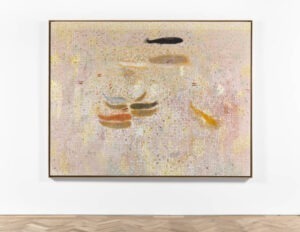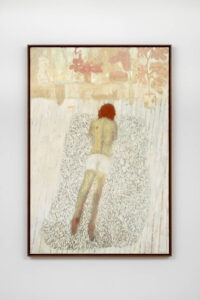The Hepworth Wakefield is for art in the north, the gift that keeps on giving, bringing contemporary painting and sculpture to audiences in a confident and non-didactic manner.
I’ve paid two visits to its current exhibition of paintings by Andrew Cranston, What made you stop here?, the second time to hear the artist talk about his work. “It chooses you rather than you choosing it,” says Cranston of his medium. “Paint becomes not what you do but who you are.”
Cranston mines his medium to produce a magnificent set of paintings, room-sized and powdery with pigment, glinting with distemper – a messy process of producing paint using pigment and glue, a process that means that he deals only in one colour at a time. The effect is of utter absorption.

Image courtesy of The Hepworth Wakefield
While scenes of outdoor and indoor colour fields stretch across the canvas, pattern and line fasten onto flattened space to denote sand dunes or playful cats on a carpet, or a shimmering ornamental pond over which goldfish forms hover with a sense of menace. Reading his notes that accompany a particular painting, also titled ‘What made you stop here’, Cranston recalls his feelings about the political climate while he was painting. All of this content enters the work, along with memories of growing up in Scotland – scenes that the painting evokes are dreamlike and they feel old.
Cranston often starts his paintings by creating a series of marks on the surface, and he says the process puts him in a trance-like state, after which he sits back and finds something in there that gives him a starting point. He says it’s hard to know where ideas come from, but he can only put it down to improvising with materials, from which a personal language develops.

Image courtesy of The Hepworth Wakefield
Materials for Cranston are the reason why painting has no point of arrival – he says it is endlessly evolving, and materials are not necessarily to be revered. For example, he sources tools from hardware shops, and uses bleach to lighten areas of his canvas to reveal light that comes from inside the painting. He also slices up paintings that are not working, that may have been around for a year or more, cutting up and replacing unresolved areas of canvas to piece together new visual narratives.
Cranston’s use of space is expansive and feels domestic, populated with ephemera, dogs or mostly cats, or sparse rooms with a view. Reclining figures, long and languid, seem to reference paintings by Pierre Bonnard and yet the thin table legs of tiny, disproportionate antique furniture feel so delicate and improbable, the paintings are barely held together, yet taut with narrative. Cranston is so authentically himself through his work.
Cranston’s subjects for paintings are many and varied. While studying art foundation in Manchester, he said that one of the best and most referred to pieces of advice from his then tutor was to always be on the look-out for subjects and ask himself, ‘is it a painting?’ He is influenced by artists who allow themselves to paint about personal subjects, citing painters Davie, Munch and Breugal. But rather absorbed than studied, Cranston refers to the memory of painting.
In addition to the large immersive works, the exhibition displays many of Cranston’s small paintings on hardback book covers. These little windows, glazed with a hard-varnished topcoat, are visual stories, rich in colour and depicting a singular subject; barely bobbed heads on a sea of yellow, the back of Granny’s coat, a cat regally surveying a scattering of objects from its position on top of a regency striped chair, more fish in a bejewelled pond observed by a row of small heads perched on the edge.

Image courtesy of The Hepworth Wakefield
Cranston sometimes uses these small paintings as a model for a large painting. “It might be asking to be made big,” he says, but since he is working things out on the canvas rather than executing a plan, there is always the chance that the painting becomes something else.
Cranston is a painter who paints with his feelings. He has mastered it as a medium for storytelling and, just like poetry, it holds the attention and slows time.
Main image: Andrew Cranston, Cat and cheeseboard, by Andy Keate
Andrew Cranston: What made you stop here? is at The Hepworth Wakefield until June 2, 2024. For more information, click here.








